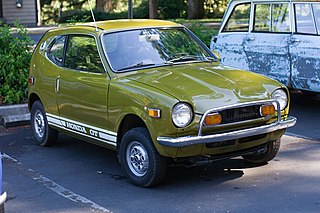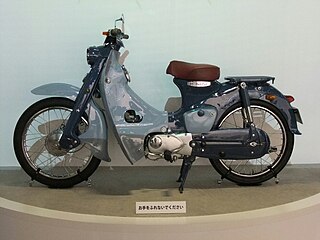
The Honda Magna is a cruiser motorcycle made from 1982 to 1988 and 1994 to 2003 and was the second Honda to use their new V4 engine shared with the VF750S Sabre and a few years later a related engine was fitted to the VF750F 'Interceptor', the later models used a retuned engine from the VFR750F with fins added to the outside of the engine. The engine technology and layout was a descendant of Honda's racing V4 machines, such as the NS750 and NR750. The introduction of this engine on the Magna and the Sabre in 1982, was a milestone in the evolution of motorcycles that would culminate in 1983 with the introduction of the Interceptor V4. The V45's performance is comparable to that of Valkyries and Honda's 1800 cc V-twin cruisers. However, its mix of performance, reliability, and refinement was overshadowed by the more powerful 1,098 cc "V65" Magna in 1983.

The Honda CB750 is an air-cooled, transverse, in-line-four-cylinder-engine motorcycle made by Honda over several generations for year models 1969–2003, plus 2007, with an upright, or standard, riding posture. It is often called the original Universal Japanese Motorcycle (UJM).
The Honda XR series is a range of four-stroke off-road motorcycles that were designed in Japan but assembled all over the world.

The Honda Z is a two-door hatchback kei car/city car manufactured and marketed by the Honda Motor Company, from 1970 until 1974. Exports mostly ended after 1972, when the domestic market models received redesigned pillarless bodywork.

The Suzuki Katana is a street motorcycle sold between 1981 and 2006 and then since 2019. It was designed in 1979–1980 by Target Design of Germany for Suzuki.

The Honda VFR750F is a motorcycle manufactured by Japanese automobile manufacturer Honda from 1986 to 1997.

The Honda Super Cub is a Honda underbone motorcycle with a four-stroke single-cylinder engine ranging in displacement from 49 to 124 cc.

The Honda CB400F is a motorcycle produced by Honda from 1975 to 1977. It first appeared at the 1974 Cologne motorcycle show, Intermot, and was dropped from the Honda range in 1978. It had an air-cooled, transverse-mounted 408 cc (24.9 cu in) inline four-cylinder engine with two valves per cylinder operated by a single chain-driven overhead camshaft. Fuelling was provided by four 20 mm Keihin carburettors. The CB400F is commonly known as the Honda 400 Four.

JAWA is a motorcycle and moped manufacturer founded in Prague, Czechoslovakia in 1929 by František Janeček, who bought the motorcycle division of Wanderer. The name JAWA was established by concatenating the first letters of Janeček and Wanderer. In the past, especially in the 1950s, JAWA was one of the top motorcycle manufacturers and exported its 350 model to over 120 countries. The best known model was the 350 Pérák, and in the 1970s the 350 Californian. It appeared in typical black and red coloring from the US to New Zealand. After 1990 a significant loss of production occurred. A successor company was formed in 1997 in Týnec nad Sázavou, continuing the name as JAWA Moto.

The Honda CG125 or Honda CG is a commuter motorcycle made by Honda of Japan. It was in production from 1976 to 2008 in Japan and has been in production since 1992 in Pakistan. The CG was originally manufactured in Japan, but the source for the European market was eventually moved to Brazil in 1985, and to Pakistan and Turkey in 1992 for the W and M models. The CG125 is powered by a 124 cc (7.6 cu in) four-stroke, overhead valve, single-cylinder engine that has changed little over the years.

The Honda N360 is a small front-engine, front-wheel drive, two-door, four-passenger car manufactured and marketed by Honda from March 1967 through 1970 in Japan's highly regulated kei class — as both a two-door sedan and three-door wagon.

Honda introduced several 200cc motorcycles with similar engines but different body variations in the 1980s. The model introduced in South Africa and Pakistan was known as the CD200 RoadMaster. The engine had the same bore as the CD185 but low compression pistons (8.8:1) with a bore and stroke of 53.0 mm × 44.0 mm, compared to 9.0:1 Compression and 53.0 mm × 41.0 mm for the CD185. The result was less power, a higher fuel economy and a lower top speed. The alternator system was also different from the CD185. Apart from this the models were quite similar, using the same frames, suspension, wheels, tyres, and brakes.

The Triumph Trident and BSA Rocket 3 was a technically advanced, high-performance roadster motorcycle made by Triumph Engineering and BSA from 1968 to 1975, and sold under both the Triumph and BSA marques. Alongside the Honda CB750, and later the Kawasaki triples, it brought a new level of sophistication to street motorcycles, marking the beginning of the superbike era. The Honda CB750 overshadowed the Trident to be remembered as the 'first superbike', in spite of the Triumph Trident actually debuting before the Honda by a few weeks.

The Kawasaki triples were a range of 250 to 750 cc motorcycles made by Kawasaki from 1968 to 1980. The engines were air-cooled, three-cylinder, piston-controlled inlet port two-strokes with two exhaust pipes exiting on the right side of the bike, and one on the left. It was the first production street motorcycle with capacitor discharge ignition (CDI). Right from the first triple model, the 1968 Mach III H1 500 cc, it was a sales success that gained a reputation for almost unmatched acceleration as well as an air of danger for inexperienced riders trying to cope with the bike's increased power to weight ratio over any previously available stock motorcycles.

The Kawasaki Z1 is a four-cylinder, air-cooled, double-overhead camshaft, carbureted, chain-drive motorcycle introduced in 1972 by Kawasaki. Following the introduction of Honda's CB750 in 1968, the Z1 helped popularize the in-line, across-the-frame four-cylinder, a format that became known as the Universal Japanese Motorcycle or UJM.
The history of the motorcycle begins in the second half of the 19th century. Motorcycles are descended from the "safety bicycle," a bicycle with front and rear wheels of the same size and a pedal crank mechanism to drive the rear wheel. Despite some early landmarks in its development, the motorcycle lacks a rigid pedigree that can be traced back to a single idea or machine. Instead, the idea seems to have occurred to numerous engineers and inventors around Europe at around the same time.

The fifth-generation Honda Civic is an automobile produced by Honda from 1991 until 1995. It debuted in Japan on September 9, 1991. At its introduction, it won the Car of the Year Japan award for the second time. Fifth-generation Civics were larger than their predecessors, had more aerodynamic bodies, and the wheelbase was increased to 257 cm (101.3 inches)—for the three-door hatchback—and to 262 cm (103.2 inches)—for the four-door sedan. The Civic Shuttle station wagon was not part of the fifth generation and was dropped for overseas markets, while the previous-generation wagon continued in Japan and Europe.

The automotive industry in Pakistan is one of the smallest but fastest-growing industries in the country, growing by 171% between 2014 and 2018. It accounts for 3% of Pakistan's GDP and employed a workforce of over 3.5 million people as of 2018. Pakistan is the 23rd largest producer of automobiles. Its contribution to the national exchequer is nearly Rs. 50-billion. Pakistan's auto market is among the smallest but fastest growing in Asia. 269,792 cars were sold in 2018, but this number declined to 186,716 in 2019 due to austerity measures. In the 1990s and early 2000s, Pakistan had many Japanese cars. With the launch of the first Auto Policy in 2005, Pakistan launched its first indigenous car, Adam Revo. However, after the 2008 elections, the dollar started depreciating, and due to bad governance, many automakers began to halt production, with some exiting Pakistan. Currently, the auto market is dominated by Honda, Toyota, and Suzuki. However, on 19 March 2016, Pakistan passed a second "Auto Policy 2016-21," which offers tax incentives to new automakers to establish manufacturing plants in the country. In response, Renault, Nissan, Proton Holdings, Kia, SsangYong, Volkswagen, FAW, and Hyundai have expressed interest in entering the Pakistani market. MG JW Automobile Pakistan has signed a memorandum of understanding (MoU) with Morris Garages (MG) Motor UK Limited, owned by SAIC Motor, to bring electric vehicles to Pakistan. NLC signed an agreement with Mercedes Benz to manufacture Mercedes Actros trucks in Pakistan. Pakistan has not enforced any automotive safety standards or model upgrade policies. A few older vehicle models, including the Bolan and Ravi, continue to be sold by Suzuki. On 8 July 2021, Jolta Electric launched the production of electric motorcycles.

A scooter is a motorcycle with an underbone or step-through frame, a seat, a transmission that shifts without the operator having to operate a clutch lever, a platform for the rider's feet, and with a method of operation that emphasizes comfort and fuel economy. Elements of scooter design were present in some of the earliest motorcycles, and motor scooters have been made since at least 1914. More recently, scooters have evolved to include scooters exceeding 250cc classified as Maxi-scooters.

The Honda C92 Benly is a 125 cc (7.6 cu in) parallel-twin motorcycle made by Honda from 1959 through 1965. Running concurrently were the CB92 Sports and the slightly larger C95 150 cc (9.2 cu in), called the CA92 and CA95 in the US. These twins took their styling and design cues from the larger-displacement Honda C71, C76, C72, C77 Dream series.


















